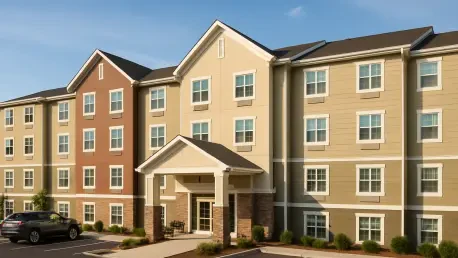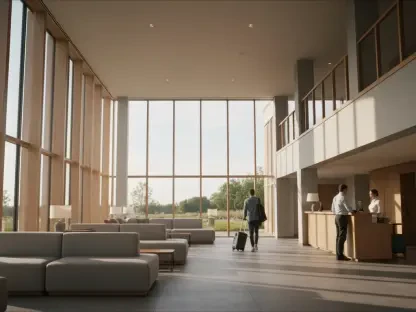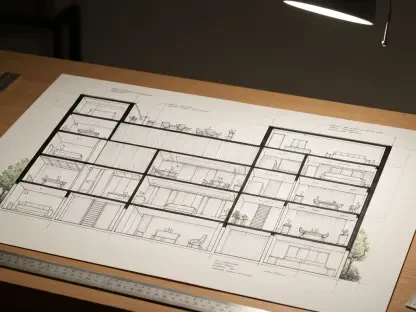The extended-stay lodging sector has carved out a significant niche in the U.S. hospitality industry, catering to guests who need accommodations for extended periods—often a week or more—due to business commitments, relocations, or personal circumstances. Unlike conventional hotels that thrive on short-term stays, these properties offer home-like amenities such as full kitchens and expansive living spaces to meet the needs of long-term residents. With over 611,000 guestrooms nationwide, making up roughly 10.3% of total hotel inventory, and revenue climbing toward a projected $20 billion milestone, the sector is experiencing remarkable growth. However, this upward trajectory is not without its obstacles. From regulatory constraints to development complexities, the industry faces a myriad of challenges that threaten to slow its momentum. Insights from industry gatherings, such as the recent ExStay D.C. Workshop hosted by the Extended Stay Lodging Association and Kalibri Labs, reveal the critical issues at play. This article explores the primary barriers to sustained expansion and the strategic efforts underway to address them, shedding light on a dynamic segment at a pivotal moment.
Navigating Market Volatility and Demand Shifts
The extended-stay lodging market is characterized by robust demand across diverse regions, from well-known hubs like Florida and Texas to emerging areas such as Ohio, but it remains vulnerable to broader economic and policy fluctuations. While room revenue has shown impressive growth in recent years, reaching $19.5 billion, external factors like federal policy changes and economic instability introduce uncertainty for stakeholders. Developers and investors must grapple with the risk of oversaturation in high-demand markets while identifying untapped opportunities in less obvious locations. This delicate balance requires a keen understanding of regional trends and guest demographics to ensure investments yield sustainable returns. Without careful planning, the sector risks uneven growth that could undermine its long-term potential, making adaptability to market dynamics a top priority for industry leaders looking to capitalize on widespread demand.
Beyond the challenge of market volatility, another layer of complexity arises in predicting and responding to shifting guest needs within the extended-stay segment. The diversity of clientele—ranging from corporate travelers to families in transition—demands a nuanced approach to property offerings and marketing strategies. Economic downturns can alter booking patterns, with some guests opting for shorter stays to cut costs, while others may extend their residencies due to financial constraints or relocation delays. Operators face the task of forecasting these shifts to maintain occupancy rates, often relying on data analytics to guide decisions. Moreover, geographic disparities in demand mean that a one-size-fits-all approach is ineffective; properties in urban centers may prioritize business amenities, while suburban locations might focus on family-friendly features. Navigating these variations is essential to avoid missteps that could jeopardize revenue streams and hinder expansion efforts in a competitive landscape.
Overcoming Development Hurdles and Rising Costs
Development of extended-stay properties, whether through new construction or conversions, presents significant challenges that can derail projects before they even begin. Securing land with proper zoning and ensuring access to critical infrastructure, such as utilities and stormwater management systems, are foundational steps that often prove time-consuming and costly. Industry experts emphasize that delays in these early stages translate directly into financial losses, as extended timelines inflate budgets in an already expensive construction environment. The pressure to expedite processes without compromising quality forces developers to adopt meticulous planning and risk mitigation strategies. Failure to address these logistical barriers can result in stalled projects, underscoring the need for efficiency to keep pace with the sector’s growth ambitions and meet rising demand.
In addition to logistical hurdles, the escalating costs of materials and labor further complicate development efforts in the extended-stay sector. Inflationary pressures in recent years have driven up expenses, squeezing profit margins for developers already navigating tight budgets. Securing financing for projects becomes more challenging as lenders grow cautious amid economic uncertainty, often requiring more stringent terms or higher equity contributions. Moreover, the unique design requirements of extended-stay properties—such as larger room layouts and in-unit kitchens—add to construction costs compared to traditional hotels. Developers must weigh these expenses against projected returns, often in markets where competition is intensifying. Strategic site selection and partnerships with experienced contractors can help mitigate some of these financial burdens, but the path to breaking ground remains fraught with obstacles that demand innovative solutions to sustain growth.
Addressing Operational Complexities for Long-Term Stays
Operationally, the extended-stay sector faces the intricate task of attracting and retaining long-term guests in a way that ensures consistent revenue while minimizing turnover. Targeting specific demographics, such as traveling nurses or individuals awaiting permanent housing, offers a pathway to stable occupancy, but it requires tailored approaches like forging ties with local apartment complexes or healthcare facilities. Operators must also make strategic decisions about prioritizing extended bookings over short-term stays during peak demand periods, a choice that can significantly impact profitability. Balancing these priorities demands a deep understanding of guest behavior and market conditions, as miscalculations can lead to vacant rooms or lost revenue opportunities, posing a persistent challenge to operational success.
Another operational concern lies in maintaining guest satisfaction over prolonged stays, which differs markedly from the transient hotel experience. Long-term residents expect a level of comfort and consistency akin to a home environment, placing pressure on properties to deliver reliable amenities and responsive service. Issues such as wear and tear on facilities, from kitchen appliances to furniture, become more pronounced with extended use, necessitating frequent maintenance that can strain budgets. Additionally, fostering a sense of community among guests can be difficult yet essential for retention, requiring staff to engage in ways that go beyond standard hospitality norms. Training teams to handle these unique demands while keeping operational costs in check is no small feat, and properties that fail to adapt risk losing their competitive edge in a segment where guest loyalty is hard-won but critical to long-term viability.
Tackling Regulatory Constraints and Local Pushback
Among the most formidable barriers to extended-stay lodging growth are the regulatory constraints imposed by local governments, which often fail to align with the sector’s business model. Many municipalities enforce zoning requirements or development standards—such as mandates for full-service restaurants or extensive event spaces—that are ill-suited to properties focused on individual, long-term guests rather than group business. These mismatched expectations can render projects financially unviable, forcing developers to either abandon plans or invest significant resources in lobbying for policy changes. The resulting delays and added expenses highlight a disconnect between local governance and industry needs, creating a frustrating bottleneck that stifles expansion in markets hungry for extended-stay options.
Compounding the issue of regulatory misalignment is the resistance from local communities and officials who may view extended-stay properties with skepticism or misunderstanding. Concerns about increased traffic, strain on public services, or perceived impacts on neighborhood character often fuel opposition to new developments, even when demand for such accommodations is evident. Developers must engage in extensive community outreach and negotiation to secure approvals, a process that can be both time-intensive and unpredictable. In some cases, municipalities impose additional fees or conditions that further erode project feasibility. Overcoming these hurdles requires not only patience but also a commitment to educating stakeholders about the benefits of extended-stay lodging, such as economic contributions and support for transient populations, to shift perceptions and pave the way for smoother project approvals.
Ensuring Strategic Brand Selection and Market Compatibility
The growing diversity of extended-stay brands introduces another layer of complexity in aligning properties with specific market needs to maximize performance. Selecting the right brand for a location demands a data-driven approach, analyzing factors like local demographics, competitor performance, and economic indicators to ensure compatibility. Misjudgments in this process can lead to underperforming assets that struggle to attract the intended guest base, resulting in diminished returns. Industry leaders advocate for leveraging insights from comparable markets and collaborating with established partners to mitigate these risks. Without such strategic foresight, the proliferation of brands can become a double-edged sword, offering variety but also amplifying the potential for costly errors in placement.
Equally critical is the challenge of adapting brand offerings to evolving guest expectations within different market segments, as a static approach can quickly become outdated. Urban markets might demand sleek, tech-focused properties catering to business travelers, while suburban or rural areas may prioritize family-oriented amenities for relocating households. Brands must remain agile, refining their value propositions to resonate with these varied audiences while maintaining consistency in quality and identity. This balancing act is further complicated by the competitive pressure to differentiate in a crowded field, where guest loyalty often hinges on unique experiences or tailored services. Operators and developers must invest in market research and ongoing performance analysis to ensure their brand remains relevant, a resource-intensive endeavor that is nonetheless vital to avoiding misalignment and securing a foothold in diverse regions.
Honoring Legacy While Driving Future Innovation
The extended-stay sector must also navigate the tension between honoring its historical foundations and embracing the innovation needed to address contemporary challenges. Celebrating the contributions of industry pioneers serves as a reminder of the vision and resilience that built this niche, inspiring current leaders to uphold high standards. However, resting on past achievements risks stagnation in a hospitality landscape shaped by rapidly changing guest preferences and technological advancements. Striking a balance between tradition and progress is essential, as the sector must adopt new tools and strategies—whether in guest engagement or operational efficiency—to remain competitive. This duality poses a unique challenge, requiring a forward-looking mindset without losing sight of the core principles that define extended-stay lodging.
Looking ahead, the industry must prioritize actionable innovation to overcome modern hurdles while drawing lessons from its storied past. This involves integrating cutting-edge technology, such as automated check-in systems or energy-efficient designs, to enhance guest experiences and reduce costs. Simultaneously, fostering a culture of adaptability ensures that operators can pivot in response to economic shifts or regulatory changes without sacrificing their foundational values. Collaboration among stakeholders—developers, operators, and policymakers—will be key to addressing systemic barriers and unlocking new growth opportunities. By blending reverence for legacy with a commitment to reinvention, the extended-stay sector can chart a path forward that not only sustains its impressive trajectory but also redefines what long-term hospitality can achieve in an ever-evolving market.









